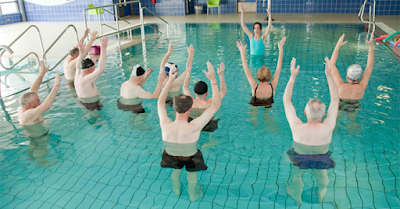Aqua therapy
Aqua therapy is any activity performed in water to assist in rehabilitation and recovery from hard training or serious injury.

In modern world of physiotherapy, Aqua Therapy is playing a vital role to rehabilitate all kind of patients, especially for paediatric to neurological, orthopedic patients. Aqua Therapy shows lot and lot of advantages is there, while doing these therapy, there is less energy is used to do those activities it means there is less energy expenditure, because water is doing assist by its property of buoyancy.
Physical properties of water:
In common with other forms of matter, water has certain physical properties which include mass, weight, density, relative density, buoyancy, Hydro static pressure, surface tension, refraction and reflection. Of the physical laws of water that the physiotherapist should understand and apply when giving Aqua Therapy, those of buoyancy and hydro static pressure are the most important. The lateral pressure exerted and the effect of buoyancy together will give the feeling of weightlessness.
1. Buoyancy:
Buoyancy is the force experienced as an upthrust which acts in the opposite direction to the force of gravity. A body in water is therefore subjected to two opposing forces. When the weight of the floating body equals the weight of the liquid displaced, and the centers of buoyancy and gravity are in the same vertical line, the body is kept in stable equilibrium. If the centers are not in the same vertical line the two forces acting on the body will cause it to roll over until it reaches a position of stable equilibrium.
2. Hydro static pressure:
The molecules of a fluid thrust upon each part of the surface area of an immersed body. Pascal's law states that fluid pressure is exerted equally on all surface areas of an immersed body at rest at a given depth. Pressure increased with the density of the fluid and with its dept. This means that swelling will be reduced more easily if exercises are given well below the surface of the water where the increased pressure may be used.
Physiological effects of Aqua therapy:
The physiological effects of water therapy combine those brought by the hot water of the pool with those of the exercises. The extent of the effects varies with the temperature of the water, the length of the treatment and the type and severity of the exercise. Usually they have to maintain temperature as well as the chlorine level. They have to ensure the purity of water as well.
The physiological effects of exercise in water are similar to those of exercise like outside of water . The blood supply to the working muscles is increased, heat is evolved with each chemical change occurring during the contraction, and the muscles temperature rises. There is an increased metabolism in the muscles resulting in a greater demand for oxygen and increased production of carbon dioxide. These changes augment the similar changes brought about by the heat of the water, and both contribute towards the final effect. The range of joint movement is either maintained or increased, and muscle power increases.
During the immersion the physiological effects are similar to those brought about by any other form of heat but less localized. A rise in body temperature is inevitable because the body gains heat from the water and from all the contracting muscles performing the exercises. As the skin becomes heated the superficial blood vessels dilate and the peripheral blood supply is increased. The blood flowing through these vessels is heated and by convection, the temperature of the underlying structures rises.
The relatively mild heat of the water reduces the sensitivity of sensory nerve endings and the muscle tone will diminish when the muscles are warmed by the blood passing through them.
Therapeutic effects:
-
Relieve pain and muscle spasm- Exercises includes strengthening and stretching exercises, helps to achieve in a remarkable way
-
To gain relaxation
-
To maintain or increase the range of joint movement- To increase the range of movements, Physios are mainly using mobilization techniques
-
To re-educate paralyzed muscles- it helps to educate the muscle even muscle power is zero
-
To strengthen weak muscles and to develop their power and endurance.
-
To encourage walking and other functional and recreational activities.
-
To improve circulation ( tropic condition of the skin )
-
To give the patient encouragement and confidence in carrying out his exercises, thereby improving his morale.
Relieve pain and muscle spasm- Exercises includes strengthening and stretching exercises, helps to achieve in a remarkable way
To gain relaxation
To maintain or increase the range of joint movement- To increase the range of movements, Physios are mainly using mobilization techniques
To re-educate paralyzed muscles- it helps to educate the muscle even muscle power is zero
To strengthen weak muscles and to develop their power and endurance.
To encourage walking and other functional and recreational activities.
To improve circulation ( tropic condition of the skin )
To give the patient encouragement and confidence in carrying out his exercises, thereby improving his morale.
No comments:
Post a Comment